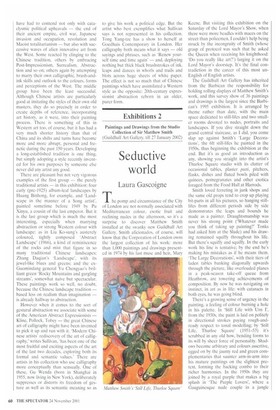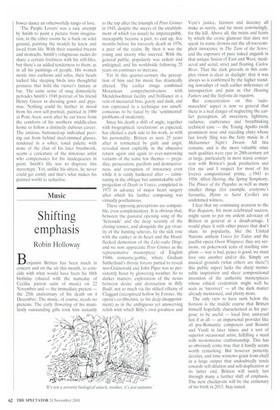Paintings and Drawings from the Studio Collection of Sir Matthew Smith (Guildhall Art Gallery, till 27 January 2002)
Seductive world
Laura Gascoigne
The pomp and circumstance of the City of London are not normally associated with Mediterranean colour, exotic fruit and reclining nudes in the afternoon, so it's a surprise to discover Matthew Smith installed at the swanky new Guildhall Art Gallery. Smith aficionados, of course, will know that the Corporation of London owns the largest collection of his work: more than 1,000 paintings and drawings presented in 1974 by his last muse and heir, Mary Keene. But visiting this exhibition on the Saturday of the Lord Mayor's Show, when there were more beadles with maces on the street than policemen, I couldn't help being struck by the incongruity of Smith (whose grasp of protocol was such that he asked the Queen when receiving his knighthood: 'Do you really like art?') larging it on the Lord Mayor's doorstep. It's the final contradiction in the career of this most unEnglish of English artists.
The Guildhall Art Gallery has inherited from the Barbican the responsibility for holding rolling displays of Matthew Smith's work, and this survey show of 36 paintings and drawings is the largest since the Barbican's 1995 exhibition. It is arranged by theme rather than date, with the main space dedicated to still-lifes and two smaller rooms devoted to nudes, portraits and landscapes. If you dive straight down the grand central staircase, as I did, you come slap up against Smith's 'Large Decorations', the 6ft still-lifes he painted in the 1950s, thus beginning the exhibition at the end. But it's as good an introduction as any, showing you straight into the artist's Thurloe Square studio with its clutter of occasional tables, plaster putti, pitchers, flasks, dishes and fluted bowls piled with quinces, pomegranates and other exotica foraged from the Food Hall at Harrods.
Smith loved ferreting in junk shops and the same old props tend to crop up playing bit-parts in all his pictures, so hanging stilllifes from different periods side by side demonstrates the leaps and bounds he made as a painter. Draughtsmanship was never his strong point (Whatever made you think of taking up painting?' Tonks had asked him at the Slade) and his drawing remained squiffy throughout his life. But there's squiffy and squiffy. In the early work his line is tentative; by the end he's making his mistakes as if he means them. 'The Large Decorations', with their tiers of laden tables banking diagonally upwards through the picture, like overloaded planes in a peak-season take-off queue from Heathrow, are towering achievements of composition. By now he was navigating on instinct, in art as in life: with cataracts in both eyes, he was going blind.
There's a growing sense of urgency in the painting, a feeling of colour burning a hole in his palette. In 'Still Life with Urn I', from the 1930s, the paint is laid on politely in directional strokes paying rough-andready respect to tonal modelling; by 'Still Life, Thurloe Square' (1951-53) it's scrubbed in any old how, bending forms to its will by sheer force of personality. Shadows become arbitrary and colours assertive, egged on by the jaunty red and green complementaries that saunter arm-in-arm into his mature paintings on the slightest pretext, forming the backing combo to their richer harmonies. In the 1950s they are joined by a royal purple that makes a big splash in 'The Purple Lovers', where a Gauguinesque nude couple in a jungle
bower dance an otherworldly tango of love.
'The Purple Lovers' was a rare attempt by Smith to paint a picture from imagination; in the other rooms he is back on solid ground, painting the models he knew and loved from life. With their rounded breasts and stomachs. Smith's voluptuous nudes do share a certain fruitiness with his still-lifes, but there's an added tenderness to them, as in all his paintings of people. His women nestle into cushions and sofas, their heads tucked like sleeping birds into thoughtful postures that hold the viewer's fantasy at bay. The same sense of snug domesticity pervades Smith's 1948 portrait of his friend Henry Green in dressing gown and pyjamas. Nothing could be further in mood from his own self-portrait, painted in 1909 at Pont Aven, soon after he cut loose from the comforts of his northern middle-class home to follow a distinctly dubious career. The anxious, buttoned-up individual peering out from behind steel-rimmed glasses, rendered in a sober, tonal palette with none of the élan of his later brushwork, seems a caricature of the timorous artist who compensates for his inadequacies in paint. Smith's life was to disprove this stereotype. Yet, unlike his sitters, he never could get comfy and that's what makes his painted world so seductive.



















































































 Previous page
Previous page